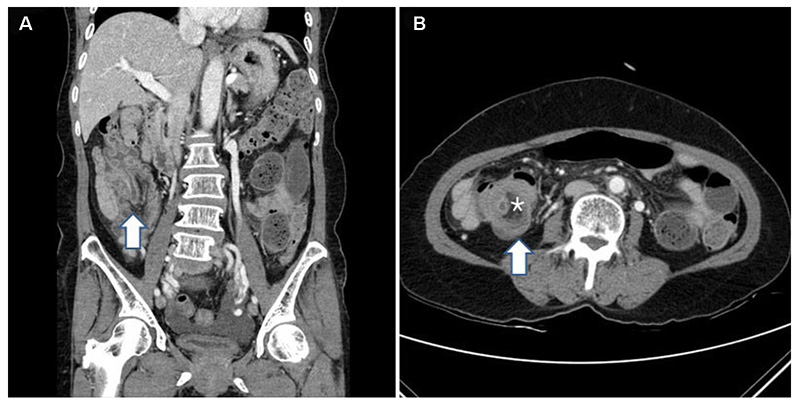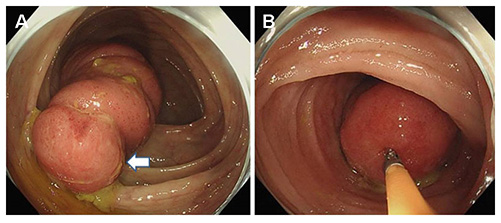Korean J Gastroenterol.
2020 Jan;75(1):46-49. 10.4166/kjg.2020.75.1.46.
Adult Ileocolic Intussusception Caused by Diffuse Large B Cell Lymphoma
- Affiliations
-
- 1Department of Internal Medicine, Pusan National University School of Medicine and Biomedical Research Institute, Pusan National University Hospital, Busan, Korea. gasong@pusan.ac.kr
- KMID: 2471139
- DOI: http://doi.org/10.4166/kjg.2020.75.1.46
Abstract
- Intussusception is a medical condition, in which a proximal part of the intestine folds into the distal intestine. Adult intussusceptions are rare and account for approximately 5% of all cases of intussusceptions. The anatomical leading points include tumors, diverticulums, polyps, and strictures in 80-90% of adult intussusceptions, and 65% of colon intussusceptions and 30% of small bowel intussusceptions originate from malignant tumors. Treatments for adult intussusception have not been established, but most cases require surgical treatment. The gastrointestinal tract is the most common extranodal site for non-Hodgkin lymphoma. The symptoms are mostly non-specific, but they rarely lead to complications, such as bleeding, perforation, and intussusception. Furthermore, few cases of primary gastrointestinal lymphomas causing intussusception have been reported. This paper reports a case of small bowel diffuse large B cell lymphoma that caused ileocolic intussusception in a 69-year-old woman with no medical history. She underwent a small bowel resection and received six cycles of adjuvant chemotherapy with rituximab, cyclophosphamide, doxorubicin, vincristine, and prednisone. Since then, she has been in complete remission.
MeSH Terms
-
Adult*
Aged
Chemotherapy, Adjuvant
Colon
Constriction, Pathologic
Cyclophosphamide
Diverticulum
Doxorubicin
Female
Gastrointestinal Tract
Hemorrhage
Humans
Intestines
Intussusception*
Lymphoma
Lymphoma, B-Cell*
Lymphoma, Non-Hodgkin
Polyps
Prednisone
Rituximab
Vincristine
Cyclophosphamide
Doxorubicin
Prednisone
Rituximab
Vincristine
Figure
Reference
-
1. Patel S, Eagles N, Thomas P. Jejunal intussusception: a rare cause of an acute abdomen in adults. BMJ Case Rep. 2014; 2014:bcr2013202593.
Article2. Kim YH, Blake MA, Harisinghani MG, et al. Adult intestinal intussusception: CT appearances and identification of a causative lead point. Radiographics. 2006; 26:733–744.
Article3. Marinis A, Yiallourou A, Samanides L, et al. Intussusception of the bowel in adults: a review. World J Gastroenterol. 2009; 15:407–411.
Article4. Kohno S, Ohshima K, Yoneda S, Kodama T, Shirakusa T, Kikuchi M. Clinicopathological analysis of 143 primary malignant lymphomas in the small and large intestines based on the new WHO classification. Histopathology. 2003; 43:135–143.
Article5. Ghimire P, Wu GY, Zhu L. Primary gastrointestinal lymphoma. World J Gastroenterol. 2011; 17:697–707.
Article6. Akbulut S. Unusual cause of adult intussusception: diffuse large B-cell non-Hodgkin's lymphoma: a case report and review. Eur Rev Med Pharmacol Sci. 2012; 16:1938–1946.7. Nam S, Kang J, Park H, Lee KY, Sohn SK. Adult ileocecal intussusception caused by malignant lymphoma. Korean J Clin Oncol. 2014; 10:46–48.
Article8. Hong KD, Kim J, Ji W, Wexner SD. Adult intussusception: a systematic review and meta-analysis. Tech Coloproctol. 2019; 23:315–324.
Article9. Yin L, Chen CQ, Peng CH, et al. Primary small-bowel non-Hodgkin's lymphoma: a study of clinical features, pathology, management and prognosis. J Int Med Res. 2007; 35:406–415.
Article10. Kim YH, Lee JH, Yang SK, et al. Primary colon lymphoma in Korea: a KASID (Korean Association for the Study of Intestinal Diseases) study. Dig Dis Sci. 2005; 50:2243–2247.
Article11. Majdoub Hassani KI, El Bouhaddouti H, Ousadden A, et al. Non-Hodgkin's lymphoma revealed by an ilio-colic intussusception in a Moroccan patient: a case report. Pan Afr Med J. 2010; 4:11.
Article12. Myung SJ, Joo KR, Yang SK, et al. Clinicopathologic features of ileocolonic malignant lymphoma: analysis according to colonoscopic classification. Gastrointest Endosc. 2003; 57:343–347.
Article13. Amr MA, Polites SF, Alzghari M, Onkendi EO, Grotz TE, Zielinski MD. Intussusception in adults and the role of evolving computed tomography technology. Am J Surg. 2015; 209:580–583.
Article14. Azar T, Berger DL. Adult intussusception. Ann Surg. 1997; 226:134–138.
Article15. Wang LT, Wu CC, Yu JC, Hsiao CW, Hsu CC, Jao SW. Clinical entity and treatment strategies for adult intussusceptions: 20 years' experience. Dis Colon Rectum. 2007; 50:1941–1949.
Article16. McKay R. Ileocecal intussusception in an adult: the laparoscopic approach. JSLS. 2006; 10:250–253.
- Full Text Links
- Actions
-
Cited
- CITED
-
- Close
- Share
- Similar articles
-
- Two cases of cecal lymphoma causing intussusception
- Chronic Intussusception Caused by Diffuse Large B-Cell Lymphoma in a 6-Year-Old Girl Presenting with Abdominal Pain and Constipation for 2 Months
- A 9-Month-Old Boy with a Recurrent Ileocolic Intussusception Caused by Diffuse Large B Cell Lymphoma: A Case Report
- Two Cases of Benign and Malignant Lesion Caused Ileocolic Intussusception: Preoperative Colonoscopic Reduction was Attempted for These Patients
- Primary Malignant Lymphoma of the Terminal Ileum Causing Intussusception in Adults





